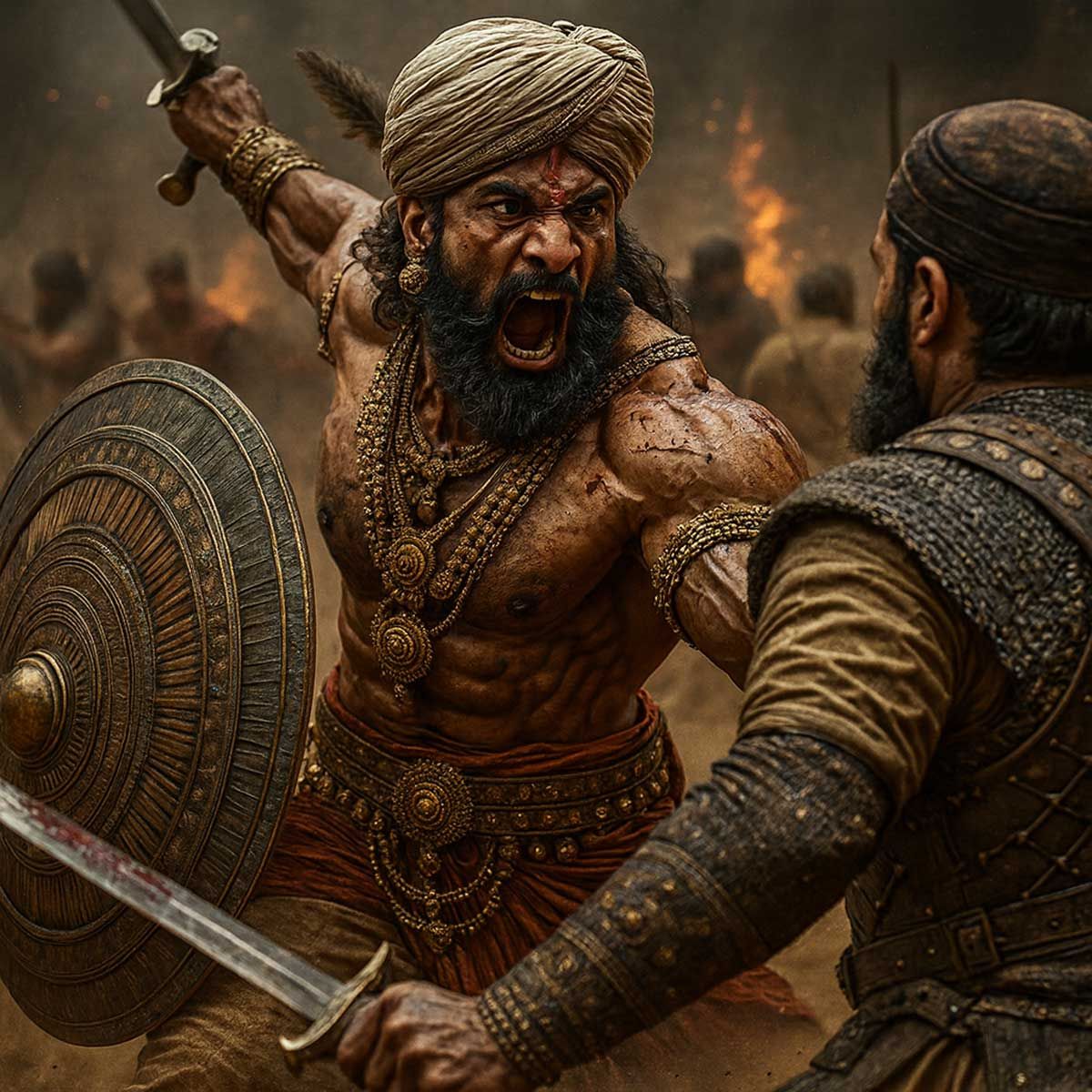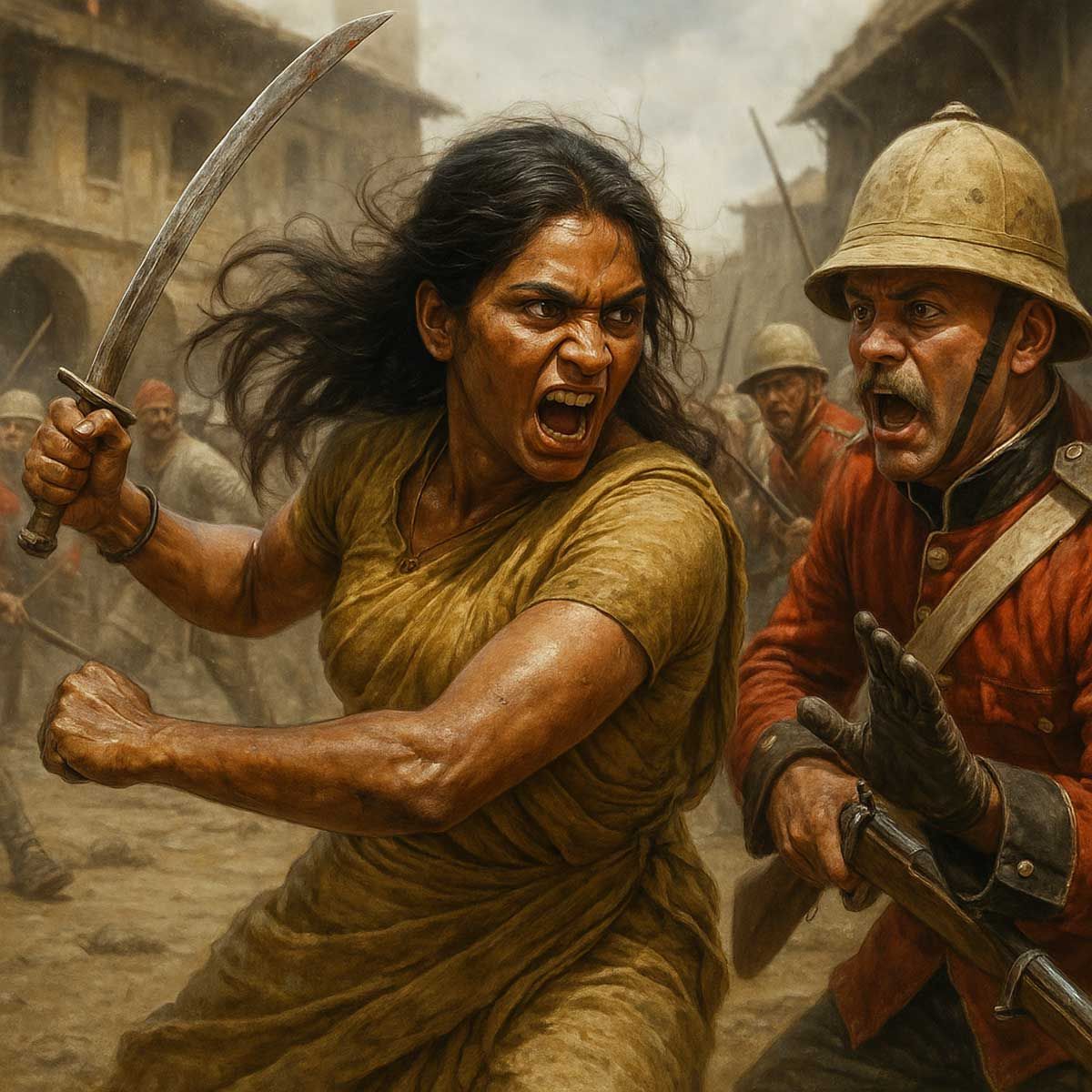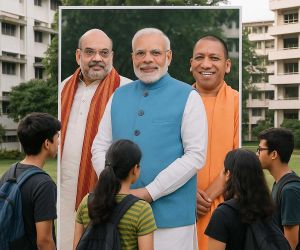MORE COVERAGE
Twitter Coverage
Satyaagrah
Written on
Satyaagrah
Written on
Satyaagrah
Written on
Satyaagrah
Written on
Satyaagrah
Written on
JOIN SATYAAGRAH SOCIAL MEDIA
"Uncover a hidden aspect of history": The mystery surrounding King Vikramaditya's reign and his illustrious Navaratnas, journey through time, exploring the legends of Kalidasa to Vetala Bhatta, unraveling a historical enigma from the 1st century BCE
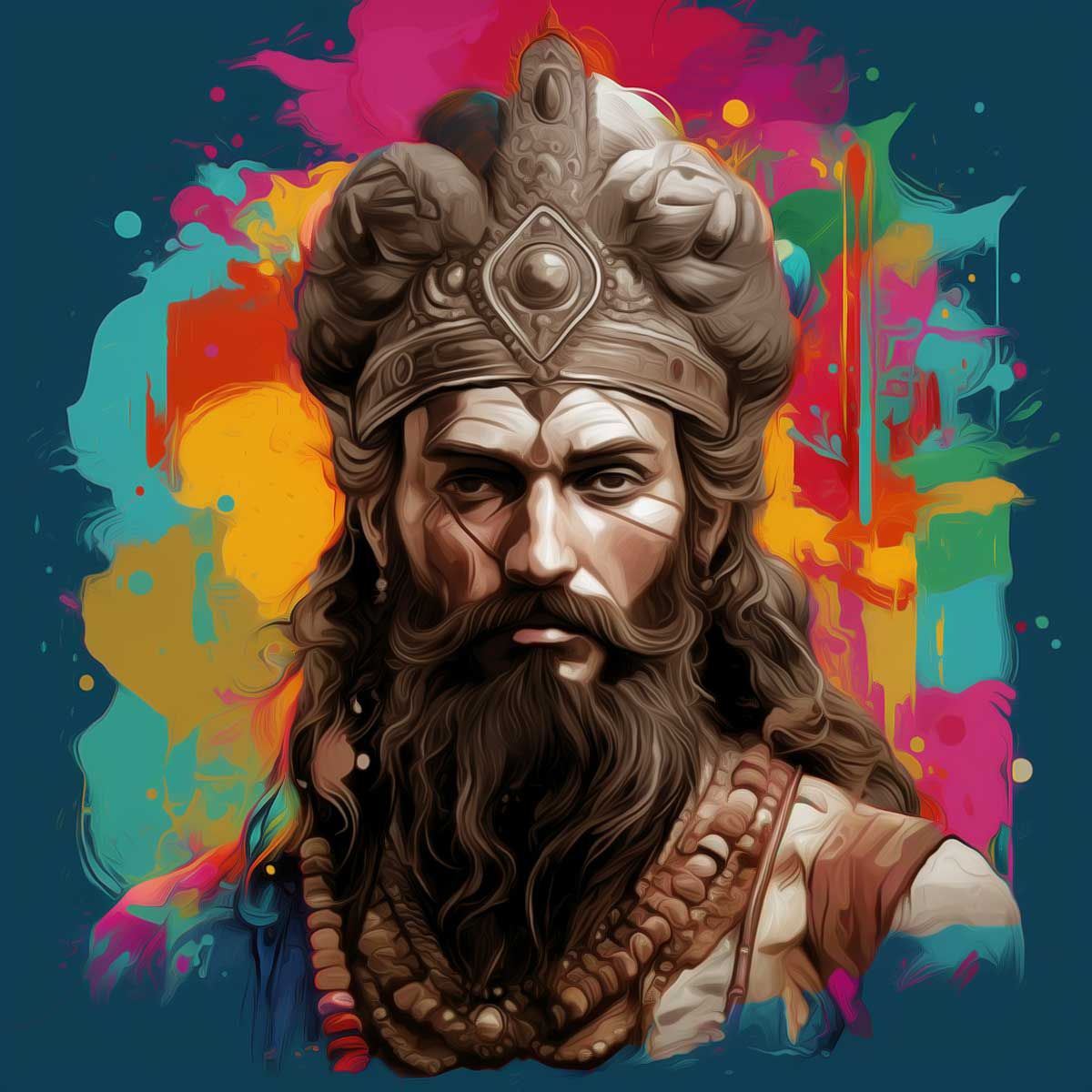
History often unravels tales and legends that spark debate among scholars. One such contentious issue revolves around the historicity of King Vikramāditya and the contemporaneity of his famed Navaratnas or nine gems. Many renowned historians have been skeptical, if not outright dismissive, about both these historical entities.
Their skepticism springs from a distorted chronological framework that doesn't accommodate King Vikramāditya. In what could be considered an academic faux pas, these historians audaciously date the celebrated poet Kālidāsa before the illustrious astrologer Varāhamihira. This chronology flies in the face of references made by Kālidāsa himself. In his scholarly treatise Jyotirvidābharaṇam, Kālidāsa explicitly acknowledges Varāhamihira as his senior contemporary.
Given the intertwining of King Vikramāditya's history with the Navaratnas' timeline, it becomes imperative to scrutinize the dating of these nine gems. Traditional legends and references from Kālidāsa celebrate the king's court as a beacon of intellect and artistry, featuring gems like Varāhamihira, Kālidāsa, Vararuchi, Dhanvantari, Kśapaṇaka, Ghatakharpara, Śaṅku, Amarasimha, and Vetālabhaṭṭa. A poetic tribute even goes:
“Dhanvantari-Kśapaṇakāmarsiṁha-Śaṅku- Vetālabhaṭṭa-Ghaṭakarpara-Kālidāsāḥ ।
Khyāto Varāhamihiro nṛpateḥ sabhāyām Ratnāni vai Vararuchir nava Vikramasya ॥27”
धन्वंतरि-क्शपणकामर्सिंह-शङ्कु- वेतालभट्ट-घटकर्पर-कालिदासाः ।
ख्यातो वराहमिहिरो नृपतेः सभायां रत्नानि वै वररुचिर् नव विक्रमस्य ॥२७॥
Translation to English | "In the court of the king, Dhanvantari, Kśapaṇaka, Amarsimha, Śaṅku, Vetālabhaṭṭa, Ghaṭakarpara, and Kālidāsa are renowned. The illustrious Varāhamihira is also amongst them, and together with Vararuchi, they are the nine gems of Vikramāditya."
Varāhamihira (146-74 BCE)
Varahamihira was the eldest among the Navaratnas of Vikramāditya as indicated by Kālidāsa (Varāhapūrvāḥ… Khyāto Varāhamihiro….). Varāhamihira, the son of Ādityadāsa and the most celebrated astronomer of Avanti (Ujjain) was born in Kāmpilyaka or Kāpitthaka. He was the author of Pañcasiddhāntikā, Bṛhajjātakam and Bṛhat Saṁhitā.
Varāhamihira used the expressions “Śakendra-kāla”, “Śaka-bhūpa-kāla”, “Śaka-kāla”, etc., which unambiguously refer to the Śaka era (583 BCE) and not to the Śakānta era (78 CE). He indicated Śaka 427 current (157 BCE) as Karaṇābda for the calculation of Ahargaṇa (counting of days).
Saptāśvivedasaṅkhyam Śaka-kālamapāsya Chaitra-śuklādau ।
Ardhāstamite bhānau Yavanapure Saumyapasādye ॥
सप्ताश्विवेदसंख्यं शक-कालमपास्य चैत्र-शुक्लादौ ।
अर्धास्तमिते भानौ यवनपुरे सौम्यदिवसाद्ये ॥
Translation in Hindi | सप्त अश्वों की गति के अनुसार शक समय को छोड़कर चैत्र मास के शुक्ल पक्ष में, जब सूर्य मध्याह्न में है, यवनपुर में सोमवार के दिन।
“The 427th year from Śaka kāla, i.e. 583 BCE, when the sun is a half setting at Yavanapura at the beginning of Chaitra śuklapakśa and it is the beginning of Wednesday.” Considering the epoch of Śaka era in 583 BCE, the year of Śaka 427 current was 157-156 BCE and the date intended by Varāhamihira was 21st Mar 157 BCE and the weekday was Wednesday.
Amarāja Daivajña, who wrote a commentary on “Khandakhādyaka” of Brahmagupta, mentions that Varāhamihira died in Śaka 509 (74 BCE) [Navādhika-pañca-śata-sankhya-śāke Varāhamihirācāryo pam gataḥ] when the trepidation (the oscillation in the precession of equinoxes) was nil. Thus, we can roughly fix the lifetime of Varāhamihira between Śaka 427 and Śaka 509, i.e., 157-74 BCE.
Interestingly, Varāhamihira mentions the points in the ecliptic, at which, winter and summer solstices occurred in ancient times and his time (around 100 BCE).
Aśleṣārdhād-dakśiṇamuttaramayanam raverdhaniṣṭhādyām ।
Nūnam kadācidāsīd yenoktam pūrvaśāstreṣu ॥
Sāmpratamayanam savituḥ karkaṭakādyām mṛgāditaścānyāt ।
Uktabhavo vikṛtiḥ pratyakśa-parīkśaṇair-vyaktiḥ ॥29
अश्लेषार्धाद्-दक्षिणमुत्तरमयनं रवेर्धनिष्ठाद्याम् ।
नूनं कदाचिदासीद् येनोक्तं पूर्वशास्त्रेषु ॥
सांप्रतमयनं सवितुः कर्कटकाद्यां मृगादितश्चान्यात् ।
उक्तभवो विकृतिः प्रत्यक्ष-परीक्षणैर्-व्यक्तिः ॥२९॥
Translation in Hindi | अश्लेषा नक्षत्र के मध्य से रवि की दक्षिणायन और धनिष्ठा नक्षत्र से उत्तरायण शुरू होता है। यह कभी-कभार पहले शास्त्रों में कहा गया था। अब रवि की यह अयन कर्कटक राशि से शुरू होती है और मृग नक्षत्र तक चलती है। जो कहा गया है, वह विकृति के प्रत्यक्ष परीक्षण से स्पष्ट है।।२९।।
“At the time the Sun’s southward course commenced on his reaching the middle of āśleṣā, and its northward course on his reaching the beginning of Dhaniṣṭhā. This must have been the case as we find it so recorded in ancient Śāstras (Vedāṅga Jyotiṣa). But at present, the one course of the Sun commences at the beginning of Karkaṭaka (Cancer), and the other at the beginning of Makara (Capricorn).”
Aśleṣārdhād āsīd yadā nivṛttiḥ kiloṣṇakiraṇasya ।
Yuktamayanam tadāsīt sāmpratamayanam punarvasutaḥ ॥
अश्लेषार्धाद् आसीद् यदा निवृत्तिः किलोष्णकिरणस्य ।
युक्तमयनं तदासीत सांप्रतमयनं पुनर्वसुतः ॥
Translation in Hindi | अश्लेषा नक्षत्र के मध्य से जब सूर्य की तेज़ किरणें वापस हुईं। उस समय जो अयन था, वह अब पुनः वासुदेव (सूर्य) का अयन है। (अयन - (पुल्लिंग) - चलना, गति का काल)
“Once the Sun changed his course from the mid-point of Aśleṣā; but at present, the Ayana begins from the end of Punarvasu Nakśatra.” Based on the positions of solstices in the ecliptic given by Varahamihira as detailed above, it can be derived that Varāhamihira must have authored Bṛhat Saṁhitā and Pañcasiddhāntikā at the beginning of the 1st century BCE.
There is a controversy about the translation of “Punarvasutaḥ”. V Thiruvenkatacharya says that Punarvasutaḥ can mean only from the end of Punarvasu. KV Sarma states that it can mean any point of Punarvasu and therefore, the point is three-quarters of Punarvasu. Internal evidence suggests that Varāhamihira clearly indicates the specific point as Aśleṣārdhād (from the mid-point of Aśleṣā Nakśatra), Dhaniṣṭhādyām (the beginning of Dhaniṣṭhā Nakśatra), etc. Evidently, Varahamihira refers beginning point as Ādi and the mid-point as Ardha.
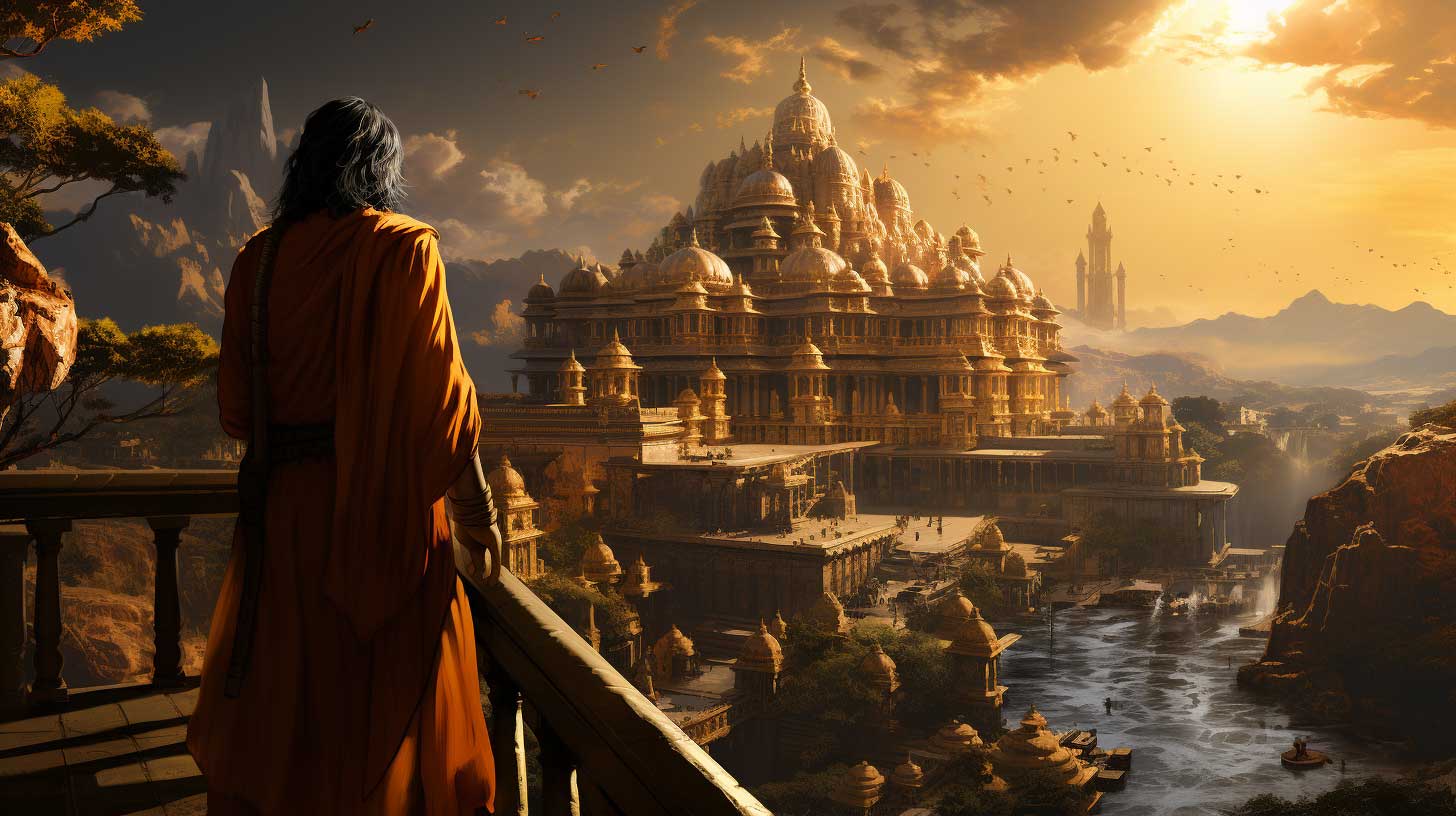 |
Therefore, Punarvasutaḥ clearly indicates the end point of Punarvasu not the point of three quarters. Thus, the summer solstice at the endpoint of Punarvasu also indicates that Varahamihira lived around ~100 BCE.
A verse from a lost text named “Kutūhalamañjari” informs us that Varāhamihira was born in the 8th tithi of the bright half of Chaitra month, in Jaya saṁvatsara and the year 3042 of Yudhiṣṭhira era. The era of the son of Sūrya-Sūnu is identical to the epoch of 3188 BCE when Yudhiṣṭhira ascended the throne of Indraprastha. Thus, the year 3042 was 146 BCE which was also the Jaya saṁvatsara. Since Varāhamihira died in 74 BCE, Jaya saṁvatsara of 146 BCE was indeed his birth year. He was born on Chaitra Śukla Aṣṭamī, i.e., 25/26 Mar 146 BCE. Thus, we can accurately fix the lifetime of Varāhamihira around 146-74 BCE.
One more argument is given that Varāhamihira mentions Āryabhaṭa (Lankārdharātra-samaye dina-pravṛttim jagāda cāryabhaṭaḥ) who was born in the 5th century CE.31 Therefore, Varāhamihira cannot be dated around 146-74 BCE. Historians have wrongly interpreted the verse “Ṣaṣṭyabdānām Ṣaṣṭir yadā vyatītāḥ trayaśca yugapādāḥ” and concluded that Āryabhaṭa was born 3600 years after the epoch of the Kaliyuga (3102 BCE).32 The internal evidence suggests that Aryabhata was completely ignorant of the Śaka era. All Indian astronomers who lived after the epoch of the Śaka era have invariably referred to the Śaka era in their treatises.
Therefore, Āryabhaṭa cannot be dated after the epoch of the Śaka era (583 BCE). Thus, Āryabhaṭa lived much earlier than the time of Varāhamihira. I have already discussed in detail the date of Āryabhaṭa in my book titled “The Chronology of India: From Manu to Mahabharata”. In fact, Āryabhaṭa flourished around 3173-3100 BCE.
As discussed above, King Vikramaditya was born in 101 BCE and ascended the throne in 82 BCE. Possibly, Varāhamihira was in the court of Vikramāditya around 82-74 BCE.
Kālidāsa (105-25 BCE)
The most celebrated Sanskrit poet, Kalidasa was one of the Navaratnas of King Vikramāditya and the author of three Kāvyas (“Ritusaṁhāram”, “Kumārasaṁbhavam”, “Raghuvaṁśam) and four Nāṭakas (“Abhijñānaśākuntalam”, “Mālavikāgnimitram”, “Vikramorvaśīyam”, “Kuntaleśvaradautyam”). Kālidāsa also authored an astronomical work named “Jyotirvidābharaṇam” in Kaliyuga 3068 (34-33 BCE).
Varṣaiḥ sindhuradarśanāmbaraguṇair-yāte kalau saṁmite,
Māse Mādhava-saṁjñake ca vihito grantha-kriyopakramaḥ ।
Nānā-kāla-vidhāna-śāstra-gadita-jñānam vilokyādarād,
Ūrje grantha-samāptiratra vihitā jyotirvidām prītaye ॥
वर्षैः सिन्धुरदर्शनाम्बरगुणैर्याते कलौ संमिते।
मासे माधवसंज्ञके च विहितो ग्रंथक्रियोपक्रमः।
नानाकालविधानशास्त्रगदितज्ञानं विलोक्यादरात्।
ऊर्जे ग्रंथसमाप्तिरत्र विहिता ज्योतिर्विदां प्रीतये॥
Translation in Hindi | कलयुग में, जब सिन्धु नदी के दर्शन और आकाश के रंग से वर्षों की गणना की जाती है, माधव नामक मास में ग्रंथ का आरंभ किया गया। विभिन्न समय-निर्धारण शास्त्रों में बताई गई ज्ञान को समझते हुए और सम्मान के साथ, कार्तिक मास में इस ग्रंथ का समाप्ति किया गया है, ज्योतिषशास्त्रीयों की प्रसन्नता के लिए।
Kālidāsa states that “I began to write this work (Jyotirvidābharaṇam) in the Kali year 3068 and in the month of Mādhava (Vaiśākha). Having consulted treatises on several systems of astronomy, I have completed the work in the month of Ūrja (Kārttika)”. Thus, Kālidāsa started writing Jyotividābharaṇam on 10th Apr 34 BCE and completed it by 1st Nov 34 BCE.
Kalidasa claims that he was one of the Navaratnas of King Vikramaditya and a junior contemporary of Varāhamihira. Kālidāsa referred to Śaka 445 elapsed (20th Mar 138 BCE) as Karaṇābda in his work (Śarāmbodhiyugo nīto hṛto mānam…….. ayanam Śakasya) for calculation of “Ahargaṇa” (counting of days).
Kālidāsa calls himself as “nṛpasakhā” which indicates that he belonged to the same age group of King Vikramāditya.
Śaṅkvādi-panditavarāh kavayastvaneke
Jyotirvidaśca prabhavaṅśca Varāhapurvāḥ।
Śri-Vikramārka-nṛpa-samsadi mānyabuddhiḥ
tairapyaham nṛpasakhā kila Kālidāsaḥ॥
शङ्क्वादि-पंडितवराः कवयस्त्वनेके
ज्योतिर्विदश्च प्रभवांश्च वराहपुर्वाः।
श्री-विक्रमार्क-नृप-संसदि मान्यबुद्धिः
तैरप्यहं नृपसखा किल कालिदासः॥
Translation in Hindi | शंकु आदि अनेक पंडित और कवियों, ज्योतिषियों और प्रभावशाली लोगों के बाद वराहमिहिरा। श्री विक्रमार्क नृप की सभा में मान्य बुद्धि के रूप में, उन सभी के बीच मैं भी राजा का मित्र कालिदास था।
Vikramāditya fought the Śakas in the North-western region and defeated a Śaka king of the province “Rummakeśa” as recorded in Kālidāsa’s Jyotirvidābharaṇam.
“Yo Rummakeśādhipatim Śakeśvaram
jitvā gṛhito’jjayinim mahāhave।
Aniya sambhrāmya mumoca tam tvaho
Śri-Vikramārka-samasahyavikramaḥ ॥”
यो रुम्मकेशाधिपतिं शकेश्वरं
जित्वा गृहीतोऽज्जयिनिं महाहवे।
अनिय संभ्राम्य मुमोच तं त्वहो
श्री-विक्रमार्क-समसह्यविक्रमः ॥
Translation in Hindi | जो रुम्मकेश के स्वामी और शक सम्राट को महायुद्ध में परास्त कर उस अज्जयिनी को बंधक बनाया। बिना किसी हलचल के वह उसे मुक्त कर दिया, वह श्री-विक्रमार्क था, जिसका पराक्रम अतुलनीय था।
Al Beruni also mentions that Vikramaditya marched against a Śaka king and killed him in the region of Karur, between Multan and the castle of Loni. The war between Vikramāditya and the Śaka king ought to have taken place around 57 BCE.
King Vikramāditya established a vast kingdom in Central and Northern India. According to Kālidāsa’s Jyotirvidābharaṇam, Vikramāditya II conquered Draviḍa, Lāta, Vaṅga, Gauḍa, Gurjara, Dhārā and Kāmboja. Undoubtedly, Vikramāditya II also known as Harṣadeva was a contemporary of the early Chālukya King Pulakeśin II.
Considering the epoch of the Śaka era in 583 BCE, Pulakeśin II reigned in the 1st century BCE. Vikramāditya II lost control over Draviḍa (Andhra and Chola kingdom) during the conflict between him and Pulakeśin II. Pulakeśin II claimed victory over Harsha, the lord of Uttarāpatha, in his copper plate grants. Undoubtedly, the “Harsha”, “Sri Harsha”, “Harshavardhana”, etc., mentioned in the early Chālukya grants were none other than Vikramāditya II and the war between Harṣa (Vikramāditya II) and Pulakeśin II occurred prior to 53 BCE.
Vikramāditya II sent Kālidāsa as his emissary to the court of Kuntaleśvara, i.e., Pulakeśin II after his defeat. Kālidāsa beautifully narrates his experience as an emissary in his work “Kuntaleśvaradautyam” which is unfortunately now lost. Historians have concocted that Pulakeśin II was a contemporary of the Puṣpabhūti King Harshavardhana of Kanauj but he flourished around 457-405 BCE. We will discuss the epoch of the Sri Harsha era in Chapter 6.
Kśemendra, the author of “Aucityavicāracarcā”, quotes a verse from Kālidāsa’s Kuntaleśvaradautyam as an illustration of Adhikaraṇaucitya (propriety of place): Kālidāsa was sent as the ambassador of King Vikramaditya to the court of the king of Kuntala, i.e. the early Chālukya King Pulakeśin II (52-22 BCE) where he did not get a seat worthy of an ambassador of a great king like Vikramāditya, and therefore, sat on the ground. When asked why he did so, Kālidāsa recited the following verse:
Iha nivasati meruḥ śekharaḥ kśmādharāṇām,
iha vinihitabhāraḥ sāgaraḥ sapta cānye ।
idam mahipatibhoga-sthambhavibhrājamānām,
dharaṇitalamihaiva sthānamasmadvidhānām ॥
इह निवसति मेरुः शेखरः क्ष्माधराणाम्,
इह विनिहितभारः सागरः सप्त चान्ये।
इदं महिपतिभोग-स्तम्भविभ्राजमानाम्,
धरणितलमिहैव स्थानमस्मद्विधानाम् ॥
Translation in Hindi | इस स्थल पर मेरु पर्वत, पृथ्वी के शिखर रूप में निवास करता है, इसी स्थल पर सात समुद्र, अपने भार सहित स्थित हैं। यह भूमि महाराजा की उपभोग के लिए चमकती हुई है, और इसी धरती पर हमारे जैसों के लिए एक स्थान है।
“This is the only proper seat for us, which is rendered immovable by the numerous pillar-lik hoods of the Śeṣa Nāga (lord of serpents); since it is here that Meru, the lord of mountains and also the seven seas are seated. And I am in no way inferior to them.”
Śriṅgāraprakāśa of King Bhoja also quotes from Kālidāsa’s Kuntaleśvaradautyam from which it is quite clear that Kālidāsa’s visit to the court of Chālukya King Pulakeśin II was eventful. Ravikīrti, the author of the Aihole inscription of Śaka 556 (27 BCE), proudly mentions the names of Kālidāsa and Bhāravi. It can be concluded from the above that Kālidāsa was the court poet of the Ujjain King Vikramāditya and flourished in the 1st century BCE.
Historians mistakenly identify the Gupta King Chandragupta Vikramāditya as the patron of Kālidāsa. Vākāṭaka King Pravarasena II, the son of the daughter of Chandragupta II, wrote a Kāvya “Setubandha” in Prakrit which had been revised or re-composed in Sanskrit by Kālidāsa by the order of King Vikramaditya as stated by the commentator Rāmadāsa.
Chandragupta II, the maternal grandfather of Pravarasena II, died at least a few years before the Setubandha could have been written. Kālidāsa, who refers to himself as “nṛpasakhā” which means the same age group friend of Vikramāditya, may have also died by then. Therefore, Chandragupta II was not the Vikramāditya who patronized Kālidāsa. We will discuss the chronology of the Gupta and the Vakataka dynasties in Chapter 9. Evidently, the famous Sanskrit poet Kālidāsa was in the court of King Vikramaditya of the 1st century BCE and lived around 105-25 BCE.
Vararuchi (100-20 BCE)
Vararuchi was also in the court of Vikramāditya. He himself records that he authored “Patrakaumudī” by the directions of Vikramāditya.
Vikramāditya-bhūpasya Kīrti-siddhernideśataḥ ।
Śriman Vararuchirdhīmān tanoti Patrakaumudīm ॥
विक्रमादित्य-भूपस्य कीर्ति-सिद्धेर्निदेशतः।
श्रीमान् वररुचिर्धीमान् तनोति पत्रकौमुदीम्॥
Translation in Hindi | विक्रमादित्य राजा की प्रशिद्ध कीर्ति की निर्देशना से, महापुरुष वररुचि धीरज पूर्वक "पत्रकौमुदी" रचता है।
Vararuchi also authored “Liṅgaviśeṣavidhi” and “Vidyāsundaraprasaṅga-kāvyam” (Vararuchināmā sa kaviḥ śrutvā vākyam nṛpendrasya । Vidyāsundara-charitam ślokasamuhaistadārebhe ॥).
There were many famous scholars named Vararuchi existed in ancient India starting from Vararuchi Kātyāyana, a contemporary of Pāṇiṇi (1670-1590 BCE).
Dhanvantari (1st century BCE)
Dhanvantari, the author of Nighanṭu and Dravyāvalī was one of the nine gems of King Vikramaditya. Probably, he was a royal physician. Unfortunately, we have no further information of Dhanvantari of the 1st century BCE.
Kśapaṇaka (1st century BCE)
There were two Sanskrit poets named Ksapaṇaka and Mahā-Kśapaṇaka. Kśapaṇaka was a great grammarian who wrote a treatise titled “Mahānyāsa”. His treatise was known as “Kśapaṇaka-Vyākaraṇa”. Mahākśapaṇaka was the author of “Anekārtha-Dhvani-Mañjarī” (also known as “Nānārtha-Dhvani-Mañjarī”).
Seemingly, he belonged to Kashmir as recorded at the end of two chapters of Anekārtha-Dhvani-Mañjarī (Kashmirānvaye Mahā-Kśapaṇaka-kavi-viracitānekārtha- Dhvani-Mañjaryām slokādhikāraḥ). There is only one śloka available in Sanskrit literature, which is attributed to Kśapaṇaka. Evidently, there was a grammarian and poet named Kśapaṇaka indeed existed.
Kālidāsa informs us that Ksapaṇaka was also one of the nine gems of King Vikramāditya of the 1st century BCE. Probably, Kśapaṇaka and Mahākśapaṇaka were two different persons.
Amarasimha (85-0 BCE)
Amarasimha was the famous author of “Amarakośa” also known as “Nāmaliṅgānuśāsanam”. Most probably, he was a Buddhist. An inscription found at Bodh Gaya mentions Amarasimha, a gem of the court of King Vikramaditya. Most probably, Amarasimha was younger than Vararuchi and Dhanvantari. According to Kśīraswāmi and Sarvananda, the commentators of Amarakośa, the treatises like Vyādi’s Utpalini, Kātyāyana’s Kātya-kośa, Vachaspati’s Śabdārṇava, Bhāguri’s Trikānḍakośa, Vikramāditya’s Saṁsārāvarta, Dhanvantari’s Nighanṭu, Amaradatta’s Amaramālā and Vararuchi’s Liṅgaviśeṣavidhi were written before Amarasimha’s Nāmaliṅgānuśāsanam.
Śaṅku (1st century BCE)
Sanku was also one of the Navaratnas of King Vikramaditya. Unfortunately, we have no information about this great scholar. Some scholars have mistakenly identified the Kashmiri poet Śaṅkuka to be one of the Navaratnas of King Vikramāditya. Kalhaṇa tells us that Śaṅkuka was the author of “Bhuvanābhyudayam”. He was a contemporary of Kashmir King Ajitāpīda and a younger contemporary of Bhaṭṭa Lollaṭa.
According to legends, Śaṅkuka was the son of Mayūra. It may be noted that Mayūrabhaṭṭa, the author of Sūryaśatakam and the brother-in-law or son-in-law of Bāṇabhaṭṭa belonged to Bihar whereas Mayūra, the father of Śaṅkuka belonged to Kashmir. Śaṅkuka was also the author of a commentary on Bharata’s Nāṭyaśāstra as quoted by Abhinavagupta.
We will discuss the date of Śaṅkuka with reference to the chronology of Kashmir. Evidently, Śaṅkuka cannot be dated in the 1st century BCE. Moreover, neither Mammaṭa nor Kalhaṇa referred to Śaṅkuka as one of the Navaratnas of Vikramaditya.
Vetāla Bhaṭṭa (1st century BCE)
It is believed that Vetala Bhaṭṭa was the author of “Vetālapañcavimśatikā” but the original source of this text is Guṇāḍhya’s Bṛhatkathā. Presently, the versions of Vetālapañcavimśatikā edited by Jambhalabhaṭṭa, Vallabhadāsa and Śivadāsa are available. Vetala Bhaṭṭa was also the author of Nītipradīpa Kāvya.
A fragmentary manuscript of Nītipradīpa Kāvya is available which contains only 16 verses. This manuscript clearly mentions Vetāla Bhaṭṭa as the author (Iti Śri-Mahākavi-Vetālabhaṭṭa-viracitam Nītipradīpakāvyam samāptam). Evidently, Vetāla Bhatta, a great poet, was one of the Navaratnas of King Vikramaditya.
Ghaṭakharpara (1st century BCE)
Ghaṭakharpara was the author of Nītisāra and Ghaṭakharpara-Kāvyam. There are eight commentaries on Ghaṭakharpara-Kāvyam. Abhinavagupta wrote a commentary named “Kulaka-Vṛtti” on Ghaṭakharpara-Kāvyam.
Seemingly, Ghaṭakharpara was his nickname but we have no information about his original name. In fact, he posed a challenge that if any poet defeats him in “Yamaka”, he will fill water for him with a Ghaṭa-Kharpara, i.e., a broken pot. This is how he came to be known as “Ghaṭakharpara”.
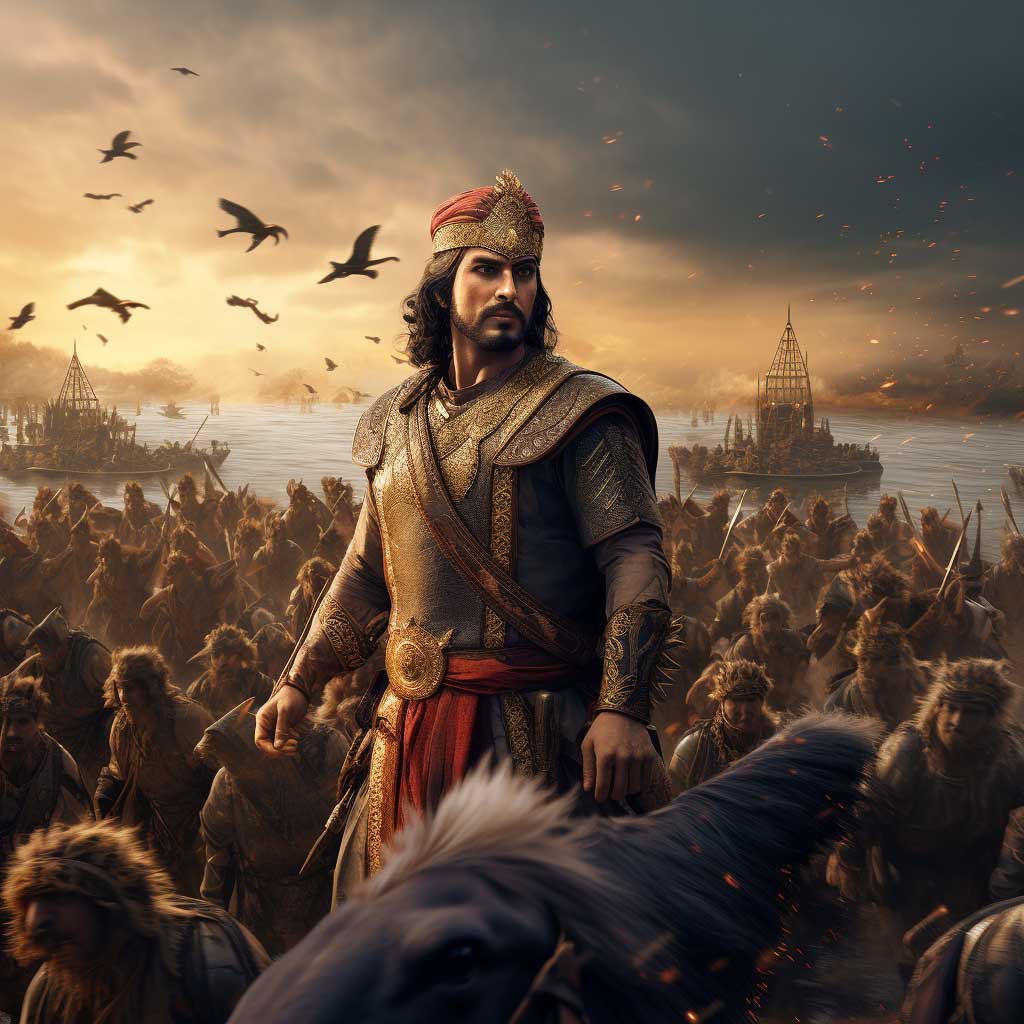 |
References
The above article is an extract from the book Chronology of India: From Mahabharata to Medieval Era by Vedveer Arya.
 Support Us
Support Us
Satyagraha was born from the heart of our land, with an undying aim to unveil the true essence of Bharat. It seeks to illuminate the hidden tales of our valiant freedom fighters and the rich chronicles that haven't yet sung their complete melody in the mainstream.
While platforms like NDTV and 'The Wire' effortlessly garner funds under the banner of safeguarding democracy, we at Satyagraha walk a different path. Our strength and resonance come from you. In this journey to weave a stronger Bharat, every little contribution amplifies our voice. Let's come together, contribute as you can, and champion the true spirit of our nation.
 |  |  |
| ICICI Bank of Satyaagrah | Razorpay Bank of Satyaagrah | PayPal Bank of Satyaagrah - For International Payments |
If all above doesn't work, then try the LINK below:
Please share the article on other platforms
DISCLAIMER: The author is solely responsible for the views expressed in this article. The author carries the responsibility for citing and/or licensing of images utilized within the text. The website also frequently uses non-commercial images for representational purposes only in line with the article. We are not responsible for the authenticity of such images. If some images have a copyright issue, we request the person/entity to contact us at This email address is being protected from spambots. You need JavaScript enabled to view it. and we will take the necessary actions to resolve the issue.
Related Articles
- Tirot Singh: An Unsung Hero of the Khasi Tribe who destroyed British with his skill at Guerrilla Warfare
- Unsung Heroine Pritilata Waddedar, Who Shook The British Raj at the age of 21
- 16 year old freedom fighter Shivdevi Tomar, who killed 17 Britishers and wounded many
- Freedom struggle of Gurjars against Britishers at Koonja in 1824: 100s of Gurjars Martyred and 100s Hung in Single Tree
- 21-yr-old girl Bina Das shot Bengal Governor in her convocation programme at Calcutta University, got Padma Shri but died in penury
- Kartar Singh Sarabha - The Freedom fighter who was Hanged at the age of 19 and inspired Bhagat Singh
- The Untold Story of the Brave Maratha Warrior Queen Ahilyabai Holkar!
- Godse's speech and analysis of fanaticism of Gandhi: Hindus should never be angry against Muslims
- Jhalkaribai: The Indian Rebellion Of 1857 Who Took on British Forces Disguised as Laxmibai
- After removing 500 tons of garbage, 18th-century old stepwell to soon serve with clean, fresh groundwater gushing from 53 feet deep water stream: Nalla Pochamma Temple, Telangana
- Paramahansa Yogananda: Spiritual journey of a saint who was known as The Father of Yoga in the West
- Dangers of losing our identity: Guru Tegh Bahadur forgotten and Aurangzeb being glorified
- अथ रामचरितमानस प्रकाशन कथा: गीता प्रेस, गोरखपुर ने 1938 से रामचरितमानस का प्रकाशन शुरू किया
- Bhagwan Parashurama – Chiranjeevi Avesha avatar of Bhagwan Vishnu
- The Forgotten Story of Rani Abbakka Chowta, the Fearless Warrior Queen of Tulu Nadu

